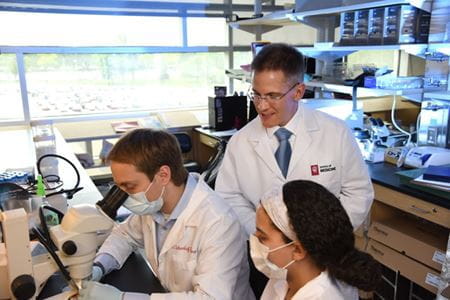The Corson Lab in the Department of Ophthalmology at Indiana University School of Medicine has developed the first drug-like inhibitor of ferrochelatase, paving the way for a new class of potential drugs for treating neovascular eye diseases.
The lab, led by Tim Corson, PhD, specializes in the study of ocular neovascularization, or abnormal blood vessel growth in the eye, which is a key feature of diseases like age-related macular degeneration, diabetic retinopathy and retinopathy of prematurity. The enzyme ferrochelatase is responsible for making heme (heme is the red pigment found in blood, but cells use heme in many ways); and ferrochelatase activity is important for the abnormal new blood vessel growth associated with these major blindness-causing diseases.
In 2017, the Corson Lab discovered ferrochelatase as a mediator of ocular angiogenesis. Ever since, researchers have been working to find new ways to inhibit it.
Now, they’ve discovered new chemicals that could also be the beginnings of a new class of drug. These chemicals will also be useful tools to further exploration of ferrochelatase.
The findings were published in the scientific journal Cell Chemical Biology.
“With much more future work, our ferrochelatase inhibitors might have potential as therapies for eye diseases characterized by abnormal blood vessel growth, especially wet age-related macular degeneration, but also proliferative diabetic retinopathy, retinopathy of prematurity, and others,” Corson said.
The research team screened thousands of chemicals to learn their ability to block ferrochelatase activity and optimized some using biochemical and cellular assays. One chemical was an effective therapy in a mouse model with features of wet age-related macular degeneration.
Now, the lab hopes to continue work in this area by making chemicals more potent and for further assessments to ensure they aren’t toxic. From there, Corson’s researchers can explore how best to deliver these therapeutically to the eye.
“To avoid vision loss, patients with these diseases usually need injections into their eyes, and even then, not all patients respond to those therapies,” Corson said. “Therefore, new strategies for blocking blood vessel growth that could potentially be delivered by routes like eyedrops are appealing.”
The Corson Lab will also immediately use the chemicals as powerful tools in ongoing lab studies of how ferrochelatase functions to regulate blood vessel growth.
This project was a large international collaboration between researchers at the Marilyn and Eugene Glick Eye Institute and others across the globe.
Kamakshi Sishtla, a research analyst in the Corson Lab in Indianapolis, served as lead author of the study in Cell Chemical Biology. Also contributing were the groups of South Korean medicinal chemist Seung-Yong Seo at Gachon University and with and structural biologist Soo Jae Lee at Chungbuk National University.
Funding support included a Macular Degeneration Research grant from the BrightFocus Foundation, as well as grants from the National Institutes of Health and the Korean National Research Foundation.
